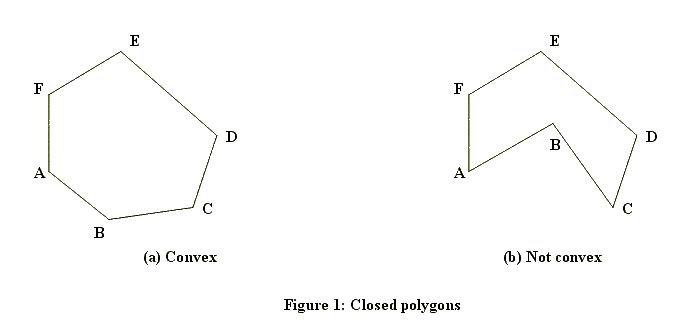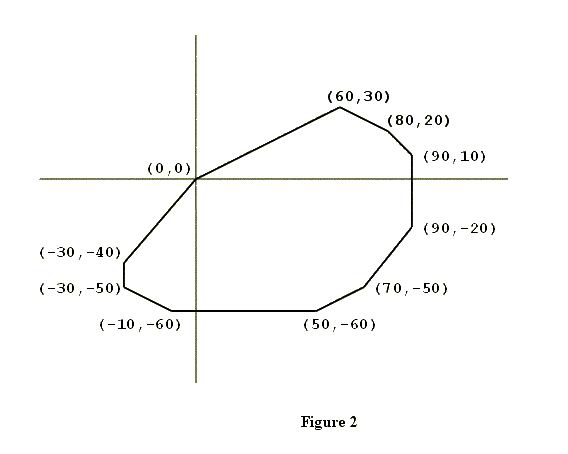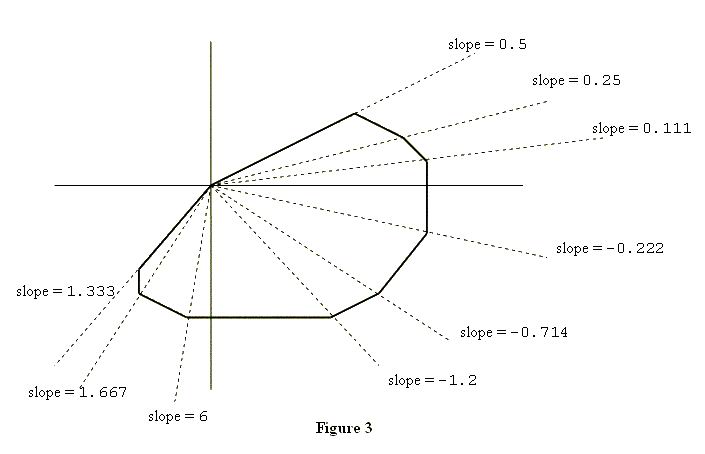POJ2007 Scrambled Polygon
来源:互联网 发布:淘宝买止咳水的暗语 编辑:程序博客网 时间:2024/06/05 15:10
Scrambled Polygon
Time Limit: 1000MS Memory Limit: 30000KTotal Submissions: 5515 Accepted: 2626
Description
A closed polygon is a figure bounded by a finite number of line segments. The intersections of the bounding line segments are called the vertices of the polygon. When one starts at any vertex of a closed polygon and traverses each bounding line segment exactly once, one comes back to the starting vertex.
A closed polygon is called convex if the line segment joining any two points of the polygon lies in the polygon. Figure 1 shows a closed polygon which is convex and one which is not convex. (Informally, a closed polygon is convex if its border doesn't have any "dents".)

The subject of this problem is a closed convex polygon in the coordinate plane, one of whose vertices is the origin (x = 0, y = 0). Figure 2 shows an example. Such a polygon will have two properties significant for this problem.
The first property is that the vertices of the polygon will be confined to three or fewer of the four quadrants of the coordinate plane. In the example shown in Figure 2, none of the vertices are in the second quadrant (where x < 0, y > 0).
To describe the second property, suppose you "take a trip" around the polygon: start at (0, 0), visit all other vertices exactly once, and arrive at (0, 0). As you visit each vertex (other than (0, 0)), draw the diagonal that connects the current vertex with (0, 0), and calculate the slope of this diagonal. Then, within each quadrant, the slopes of these diagonals will form a decreasing or increasing sequence of numbers, i.e., they will be sorted. Figure 3 illustrates this point.


A closed polygon is called convex if the line segment joining any two points of the polygon lies in the polygon. Figure 1 shows a closed polygon which is convex and one which is not convex. (Informally, a closed polygon is convex if its border doesn't have any "dents".)

The subject of this problem is a closed convex polygon in the coordinate plane, one of whose vertices is the origin (x = 0, y = 0). Figure 2 shows an example. Such a polygon will have two properties significant for this problem.
The first property is that the vertices of the polygon will be confined to three or fewer of the four quadrants of the coordinate plane. In the example shown in Figure 2, none of the vertices are in the second quadrant (where x < 0, y > 0).
To describe the second property, suppose you "take a trip" around the polygon: start at (0, 0), visit all other vertices exactly once, and arrive at (0, 0). As you visit each vertex (other than (0, 0)), draw the diagonal that connects the current vertex with (0, 0), and calculate the slope of this diagonal. Then, within each quadrant, the slopes of these diagonals will form a decreasing or increasing sequence of numbers, i.e., they will be sorted. Figure 3 illustrates this point.


Input
The input lists the vertices of a closed convex polygon in the plane. The number of lines in the input will be at least three but no more than 50. Each line contains the x and y coordinates of one vertex. Each x and y coordinate is an integer in the range -999..999. The vertex on the first line of the input file will be the origin, i.e., x = 0 and y = 0. Otherwise, the vertices may be in a scrambled order. Except for the origin, no vertex will be on the x-axis or the y-axis. No three vertices are colinear.
Output
The output lists the vertices of the given polygon, one vertex per line. Each vertex from the input appears exactly once in the output. The origin (0,0) is the vertex on the first line of the output. The order of vertices in the output will determine a trip taken along the polygon's border, in the counterclockwise direction. The output format for each vertex is (x,y) as shown below.
Sample Input
0 070 -5060 30-30 -5080 2050 -6090 -20-30 -40-10 -6090 10
Sample Output
(0,0)(-30,-40)(-30,-50)(-10,-60)(50,-60)(70,-50)(90,-20)(90,10)(80,20)(60,30)
Source
Rocky Mountain 2004
这是一道比较水的凸包问题,第一个点就是起始点,连排序都省了,水过啊
#include<iostream>#include<cstdio>#include<cstring>#include<cmath>#include<algorithm>using namespace std;int num,index;struct node{ double x,y; bool v;}p[51];//这个can函数,是这个凸包问题的核心啊,就是判断是不是凸包的下一个点int can(int a,int b){ if(a==b||p[b].v==1)return 0; for(int i=0;i<num;i++) { if(i==a||i==b)continue; if((p[b].x-p[a].x)*(p[i].y-p[a].y)-(p[b].y-p[a].y)*(p[i].x-p[a].x)<=0)return 0; } if(b==0)return 2; else return 1;}int main(){ num=0; while(scanf("%lf%lf",&p[num].x,&p[num].y)!=EOF) { p[num].v=0; num++; } index=0; cout<<"("<<p[0].x<<","<<p[0].y<<")"<<endl; while(1) { for(int i=0;i<num;i++) { int r=can(index,i); if(r==0)continue; else if(r==1) { index=i; p[i].v=1; cout<<"("<<p[i].x<<","<<p[i].y<<")"<<endl; break; } else if(r==2)return 0; } } return 0;}- POJ2007 Scrambled Polygon
- POJ2007 Scrambled Polygon
- POJ2007-Scrambled Polygon
- POJ2007--Scrambled Polygon
- POJ2007 Scrambled Polygon
- POJ2007 Scrambled Polygon
- poj2007——Scrambled Polygon
- POJ2007 Scrambled Polygon 凸多边形顶点输出
- [POJ2007]Scrambled Polygon(计算几何)
- poj2007 Scrambled Polygon【极角排序】
- poj2007-Scrambled Polygon (极角排序)
- Scrambled Polygon(poj2007极角排序输出凸包)
- ACM-计算几何之Scrambled Polygon——poj2007
- poj2007 Scrambled Polygon (叉积极角排序)
- Scrambled Polygon
- poj 2007 Scrambled Polygon
- poj 2007 Scrambled Polygon
- POJ 2007 Scrambled Polygon
- POJ 1384 完全背包问题
- java-API文档如何查阅
- SOA在当今中国企业的发展现状
- Android OpenGL ES 2.0画立方体JNI实现
- 由中序和后序确定一棵二叉树
- POJ2007 Scrambled Polygon
- Description has only two Sentences
- 缓存
- HDU 4431 Mahjong (模拟) #by Plato
- POJ1159 Palindrome
- 单片机C语言下LCD多级菜单的一种实现方法
- Wget下载终极用法和15个详细的例子
- unix 网络编程--select (一)
- MFC进修笔记2——MFC和Win32


